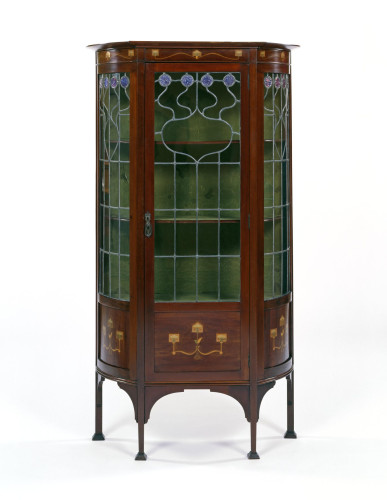5/2000
Collection
Furniture
Brief description
Mahogany display cabinet with glass panels set in lead, stamped on the base with a design registration number for 1905, made by Frederick Ficke in Hoxton, London, c.1905.
Object name
cabinet
Object number
5/2000
Production person
Frederick Ficke (designer)
Frederick Ficke (manufacturer)
Frederick Ficke (manufacturer)
Production date
c.1905 (designed)
Production place
Hoxton (manufactured)
Period
Edwardian (1901-1910)
Twentieth century (1900-1999)
Twentieth century (1900-1999)
Material
mahogany
silk
glass
lead
metal
copper
sycamore
holly
mahogany veneer
silk
glass
lead
metal
copper
sycamore
holly
mahogany veneer
Technique
inlaid
glazed
glazed
Physical description
Mahogany display cabinet, with glazed sides and a part glazed door, which has a lock, and key (5/2000-2). The clear glass panes are secured in rectangular strips of lead, holding four panes of glass across by three panes of glass high. Above these panes, the lead forms into a double ogee. From the top of the ogee there are four wavy lines made of lead, which lead to four pinky/purple rippled glass circles near the top of the door. This design is repeated in the glazing on the sides of the cabinet but the ogee is ovoid in shape. The door has a metal escutcheon with oval handle. The cabinet is semi-circular in shape with four shelves, and has an overhanging cornice. Inside the cabinet, the back and the three upper shelves are covered in green moire silk which is mainly stained on the middle shelf.
At the top of the cabinet above the door are inlaid three stylised flowers in gold coloured metal inset in squares of copper? (except for the centre flower which is inset in a five sided shape which is pointed at the top). The flowers have green and yellow stems and leaves inlaid in the wood, connected by a scrolling line, made either from sycamore or holly. This design is repeated on the left and right side of the cabinet. The bottom section of the cabinet has a larger design of the same stylised flowers, although the centre flower is raised higher. The cabinet has six spandrels to support the four legs which end in pad feet. The front two legs are tapered on all four sides. The back two legs are tapered on three sides and are flat at the back. The back of the cabinet is painted black. The cabinet is stamped towards the front of the bottom shelf with the registered design mark 'REGD / 468880' for the year 1905. There is a '4' on its side after REGD which is probably a mistake made by the maker.
At the top of the cabinet above the door are inlaid three stylised flowers in gold coloured metal inset in squares of copper? (except for the centre flower which is inset in a five sided shape which is pointed at the top). The flowers have green and yellow stems and leaves inlaid in the wood, connected by a scrolling line, made either from sycamore or holly. This design is repeated on the left and right side of the cabinet. The bottom section of the cabinet has a larger design of the same stylised flowers, although the centre flower is raised higher. The cabinet has six spandrels to support the four legs which end in pad feet. The front two legs are tapered on all four sides. The back two legs are tapered on three sides and are flat at the back. The back of the cabinet is painted black. The cabinet is stamped towards the front of the bottom shelf with the registered design mark 'REGD / 468880' for the year 1905. There is a '4' on its side after REGD which is probably a mistake made by the maker.
Dimensions
Height: 167.1cm
Width: 87cm
Depth: 38.3cm
Width: 87cm
Depth: 38.3cm
Website keywords
living room furniture
storage
storage
Label
Caption for Exploring 20th Century London website:
The cabinet-making firm Frederick Ficke made this glazed mahogany display cabinet in their Hoxton workshop around 1905, the year they registered a drawing of it with the Patent Office. By doing this, they were protecting the originality of their design - its shape, the inlaid ornamentation, the leaded ogee shapes at the top of the glass panes…This official protection was something which had first become possible with the Copyright and Design Act of 1839, and the design number stamped on the bottom of the cabinet announces its originality and protected status.
Label text for the exhibition At Home with the World, Geffrye Museum (20 March 2012- 9 September 2012):
Display cabinet
The glass doors feature some stained glass decoration. Blue glass creates flowers with curving stems made from the lead between the glass. This modest version of nature is typical of Art Nouveau design, popular at this time all over Europe and in the USA.
The cabinet-making firm Frederick Ficke made this glazed mahogany display cabinet in their Hoxton workshop around 1905, the year they registered a drawing of it with the Patent Office. By doing this, they were protecting the originality of their design - its shape, the inlaid ornamentation, the leaded ogee shapes at the top of the glass panes…This official protection was something which had first become possible with the Copyright and Design Act of 1839, and the design number stamped on the bottom of the cabinet announces its originality and protected status.
Label text for the exhibition At Home with the World, Geffrye Museum (20 March 2012- 9 September 2012):
Display cabinet
The glass doors feature some stained glass decoration. Blue glass creates flowers with curving stems made from the lead between the glass. This modest version of nature is typical of Art Nouveau design, popular at this time all over Europe and in the USA.

